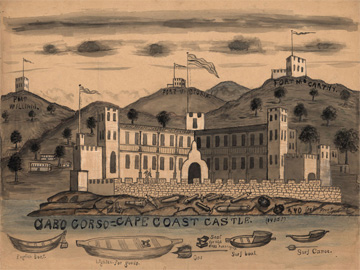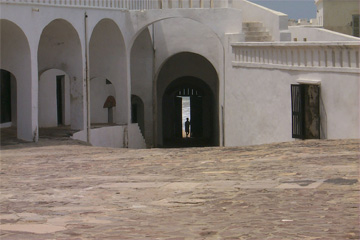Cape Coast Castle


Cape Coast Castle is a trading post on the West African coast in the modern nation of Ghana. It stands only a few miles from another slave castle built by the Portuguese at Elmina in the late fifteenth century. Originally built by Sweden in the 1650s, Cape Coast Castle shifted into Danish, Dutch, and then English possession by the 1660s. In the castle’s early decades, trade revolved around gold, wood, and textiles before English merchants began to seek captive Africans in large numbers.
Large, permanent trading factories like Cape Coast Castle gave European traders competitive advantages in the marketplace. By focusing resources in and around these sites, merchants could build alliances with local political leaders to ensure steady supplies of African commodities. The town that grew around the castle supplied labor to merchants, supplementing the castle’s own enslaved workers. In addition, relationships between European men and African women led to a significant biracial population around Cape Coast. These individuals served in military units, learned skilled trades, and provided a bridge between European and African cultures.
When Cape Coast Castle’s commerce became increasingly dependent on supplying slave cargoes, the fort added dungeons to hold larger numbers of captives. In doing this, the castle’s merchants could outfit ships more quickly, at higher prices, and with greater profits than their smaller competitors. Over the course of the eighteenth century, most of Cape Coast Castle’s trade was in African captives bound for the Americas. After Britain legally abolished the slave trade in 1807, the castle became an educational and administrative center.
History & Memory
Related Pages:
-
 Samuel Ajayi Crowther
Samuel Ajayi Crowther
-
 Advertisement of a slave auction
Advertisement of a slave auction
-
 Slavery Remembered
Slavery Remembered
-
 West Africa
West Africa
-
 Ghana Museums and Monuments
Ghana Museums and Monuments

